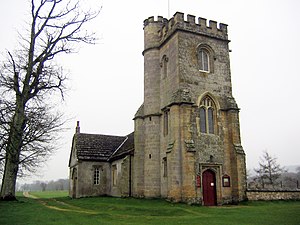Parham
Parham was a small village in the south of Sussex, facing the scarp of the South Downs a mile to the south of it, almost two miles west of Storrington. The village's few houses were destroyed in the early 19th century to create the landscaped park and gardens of Parham Park. All that now remains apart from the parkland are the parish church and the surrounding farms and hamlets. The site of the village is between Wiggonholt and Cootham, about three miles south of Pulborough on the A283 road.
The old village also gives its name to a modern civil parish covering the hamlets of Rackham, southwest of Parham Park, and Wiggonholt, west of the A283.
Parish church
The Church of England parish church, St Peter, stands within the deer park.
The church has a blocked two-bay arcade in the north wall of the nave that shows there used to be a north aisle.[1] The lower part of the bell-tower is Perpendicular Gothic and the south chapel remains as it was built in 1545, but the remainder of the building was remodelled in the Georgian Gothic fashion in about 1820.[1]
The font is a rare lead one from the middle of the 14th century, repeatedly inscribed with the legend IHS Nazar and the arms of Sir Andrew Peverel (d. 1376),[2] who was a 'Knight of the Shire' in 1351.[1]
Parham Park
- Main article: Parham Park
The grand house of the parish, Parham Park, is named after the estate and its deer park overspreading where the village used to stand. The estate originated as a grange of Westminster Abbey.[3] After the Dissolution of the Monasteries it was converted into a south-facing E-shaped Elizabethan country house.[4]
Nature reserves
Parham Park grounds are designated a Site of Special Scientific Interest,[5] with a special biological interest for its epiphytic lichen flora, as an area for two rare beetles and its large heronry.
Pulborough Brooks, a nature reserve in the north of the parish is also an SSSI. It is beside the River Arun which floods in winter, providing a rich habitat for wading birds, ducks and geese.[6] Part of the area is an RSPB reserve.
Location
- Location map: 50°55’5"N, 0°29’35"W
- Streetmap: TQ060142
Outside links
| ("Wikimedia Commons" has material about Parham) |
References
- ↑ 1.0 1.1 1.2 Nikolaus Pevsner: The Buildings of England: Sussex, 1965 Penguin Books ISBN 978-0-300-09677-4page 292
- ↑ A History of the Castles, Mansions, and Manors of Western Sussex, by Dudley George Cary Elwes, pub. 1876, p. 52.
- ↑ Nairn & Pevsner, 1965, page 290
- ↑ Nikolaus Pevsner: The Buildings of England: Sussex, 1965 Penguin Books ISBN 978-0-300-09677-4
- ↑ SSSI listing and designation for Parham Park
- ↑ SSSI listing and designation for Pulborough Brooks
- Nikolaus Pevsner: The Buildings of England: Sussex, 1965 Penguin Books ISBN 978-0-300-09677-4
